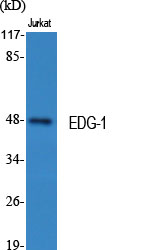Total S1P Receptor EDG1 Cell-Based Colorimetric ELISA Kit
- Catalog No.:KA4272C
- Applications:ELISA
- Reactivity:Human;Mouse;Rat
- Gene Name:
- S1PR1
- Human Gene Id:
- 1901
- Human Swiss Prot No:
- P21453
- Mouse Swiss Prot No:
- O08530
- Rat Swiss Prot No:
- P48303
- Storage Stability:
- 2-8°C/6 months
- Other Name:
- Sphingosine 1-phosphate receptor 1 (S1P receptor 1) (S1P1) (Endothelial differentiation G-protein coupled receptor 1) (Sphingosine 1-phosphate receptor Edg-1) (S1P receptor Edg-1) (CD antigen CD363)
- Detection Method:
- Colorimetric
- Background:
- function:Receptor for the lysosphingolipid sphingosine 1-phosphate (S1P). S1P is a bioactive lysophospholipid that elicits diverse physiological effect on most types of cells and tissues. This inducible epithelial cell G-protein-coupled receptor may be involved in the processes that regulate the differentiation of endothelial cells. Seems to be coupled to the G(i) subclass of heteromeric G proteins.,induction:By the tumor promoter phorbol 12-myristate 13-acetate (PME) in the presence of cycloheximide.,PTM:S1P-induced endothelial cell migration requires the PKB/AKT1-mediated phosphorylation of the third intracellular loop at the Thr-236 residue.,similarity:Belongs to the G-protein coupled receptor 1 family.,tissue specificity:Endothelial cells, and to a lesser extent, in vascular smooth muscle cells, fibroblasts, melanocytes, and cells of epithelioid origin.,
- Function:
- angiogenesis, blood vessel development, vasculature development, regulation of nucleotide metabolic process,regulation of transcription, DNA-dependent, regulation of transcription from RNA polymerase II promoter, cellular ion homeostasis, cellular calcium ion homeostasis, cellular metal ion homeostasis, cell adhesion, cell surface receptor linked signal transduction, G-protein coupled receptor protein signaling pathway, G-protein signaling, coupled to cyclic nucleotide second messenger, G-protein signaling, coupled to cAMP nucleotide second messenger, inhibition of adenylate cyclase activity by G-protein signaling, negative regulation of adenylate cyclase activity, activation of phospholipase C activity by G-protein coupled receptor protein signaling pathway coupled to IP3 second messenger,activation of phospholipase C activity, elevation of cytosolic calcium ion concentration, intracell
- Subcellular Location:
- Cell membrane ; Multi-pass membrane protein. Endosome. Membrane raft. Recruited to caveolin-enriched plasma membrane microdomains in response to oxidized 1-palmitoyl-2-arachidonoyl-sn-glycero-3-phosphocholine. Ligand binding leads to receptor internalization.
- Expression:
- Endothelial cells, and to a lesser extent, in vascular smooth muscle cells, fibroblasts, melanocytes, and cells of epithelioid origin.
- June 19-2018
- WESTERN IMMUNOBLOTTING PROTOCOL
- June 19-2018
- IMMUNOHISTOCHEMISTRY-PARAFFIN PROTOCOL
- June 19-2018
- IMMUNOFLUORESCENCE PROTOCOL
- September 08-2020
- FLOW-CYTOMEYRT-PROTOCOL
- May 20-2022
- Cell-Based ELISA│解您多样本WB检测之困扰
- July 13-2018
- CELL-BASED-ELISA-PROTOCOL-FOR-ACETYL-PROTEIN
- July 13-2018
- CELL-BASED-ELISA-PROTOCOL-FOR-PHOSPHO-PROTEIN
- July 13-2018
- Antibody-FAQs



